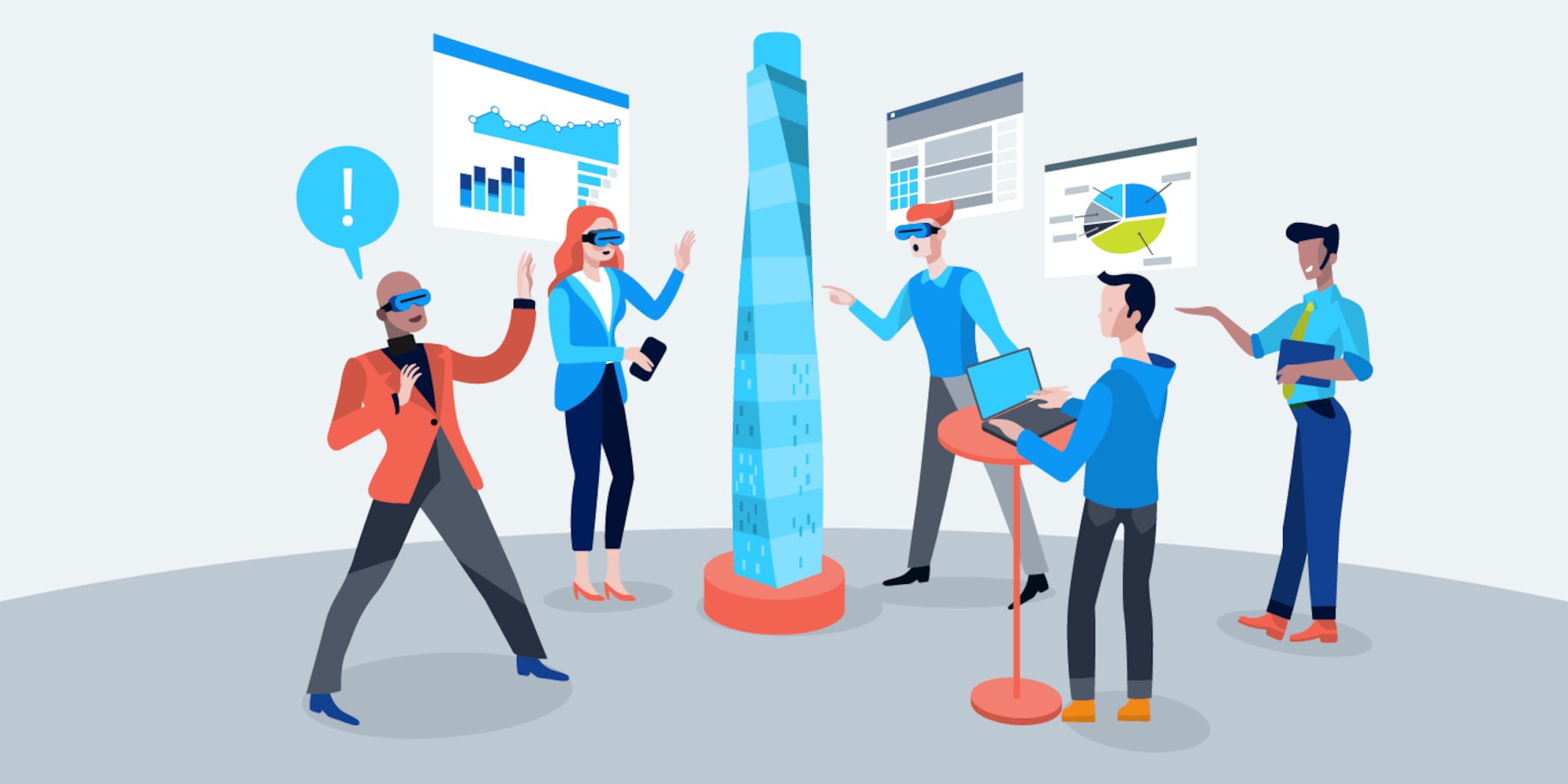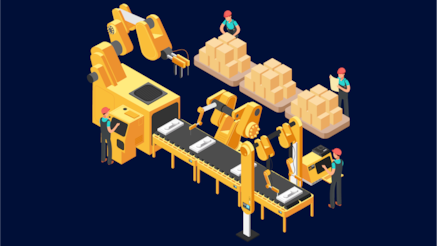Creating and experiencing new worlds with digital twins

The scale and variety of challenges facing humanity – ranging from pandemics to climate change - is unprecedented, and it is clear that staying on our current course is simply not sustainable. This means, in other words, that we have no choice but to innovate our way out of our problems and into a better future. A future that could be imagined digitally…
How digital twins are improving and disrupting the ways we work
Back in 2017, scientists predicted that within a decade AI would be able to outperform humans in many areas such as language translation and truck driving, with more complex tasks such as performing surgery by 2053. Yet even these seemingly ambitious predictions are constantly being revised as the technology outpaces expectations.
One concrete application of these AI advancements that is becoming increasingly pervasive across a wide variety of industries is digital twins, which are ideal for overseeing and optimizing machine, equipment, personnel, and site-wide operations.
Digital twins are effectively bridges between the physical and digital world. They accumulate data over time about the structure of a system, its operation, and the environment in which it operates, and this data can be used to build intelligence on top using analytics, physics, and machine learning. It therefore becomes possible to query the digital twin of a specific system and ask about its past and present performance and operations, getting early warnings and predictions and improving productivity.
Disrupting industries
Companies such as General Electric, Siemens, and IBM are investing significantly in digital twin technology, according to a report by research firm Markets and Markets.
“Every industry is being disrupted by digital technologies, and companies are increasingly turning to the power of the Industrial Internet for competitive advantage,” says Deborah Sherry, General Manager and Chief Commercial Officer at GE Digital Europe
GE’s digital twin technology creates dynamic digital representations of industrial assets that enable companies to change the way their businesses operate, and better understand and predict the performance of their machines. These are software constructs built for specific outcomes that bridge physical systems and the digital world.
Ansys simulation technologies is a software company which has been operating since the 1970’s, and is now working with Microsoft to employ physics and simulation-based analytics to decrease product maintenance costs and expediting time-to-market for a variety of clients across all sectors.
Many smaller start-ups are also making headway in developing and deploying digital twins.
"During a time when autonomous systems are on the rise, Ansys will enable cloud engineers to increase productivity and accelerate the delivery of innovative solutions," says Scott Guthrie, executive vice president, Cloud and AI at Microsoft.
The two companies are also collaborating to offer cloud-enabled autonomous vehicle (AV) simulation capabilities to joint customers. Ansys VRXPERIENCE, an AV virtual test platform runs on Microsoft’s cloud platform Azure, allows users to test drive millions of virtual miles across countless scenarios, greatly optimizing safety and development costs.
Yet this is not solely the domain of larger companies and tech giants either, as many smaller start-ups are also making headway in developing and deploying digital twins. Canadian company LlamaZOO Interactive, which is based in British Columbia works on 3D digital twinning applications that turns companies’ existing data into remotely accessible real-time visualizations. They provide mining clients with centralized real-time tracking of equipment and vehicle positioning, health, and productivity, as well as planned vs. actual dig progress.
“They can avoid unplanned maintenance by remotely monitoring machine and equipment health and data and gain centralized data oversight by integrating any number of datasets into one centralized interface,” says the company’s Board Director Kevin Oke, adding that the platform enables users to visualize the digital twin’s real-time and historic data, drill-down for detailed information on any part, machine, or process, and provide immersive cost-saving training.
AI is also being used as a catalyst for a greener, more sustainable world by identifying different material compositions for the best possible electric vehicle batteries as the worldwide shift to carbon neutrality intensifies. Building better batteries requires constant testing and optimization of each stage in the development process, and thanks to deployment of digital twin technology, InoBat’s road to discovery for new battery chemistries is 10 times faster compared to that of a traditional lab, claims the company’s Co-Founder and CEO, Marian Bocek.
Optimizing life and productivity
Productivity is a growing concern for industry, and a recently published white paper found that production and productivity, IT, and customer service are hit hardest by unplanned downtime, with damaging repercussions for businesses as a whole. 82 percent of companies surveyed across the UK, US, France and Germany have experienced at least one unplanned downtime outage over the past three years. This was also consistent across a range of sectors such as manufacturing, medical, oil and gas, energy and utilities, telecoms, distribution, logistics and transport.
By implementing digital twin capabilities, however, companies can therefore tackle the core problems that harm productivity - such as unplanned downtime – transforming reactive systems into predictive, intelligent ones.
Bentley Systems have also partnered with Microsoft to bring smart city planning and scale up the deployment of digital. Bentley’s iTwins system recreates a city or organization down to the finest detail, allowing citizens to explore proposed changes and offer comments. It is already in use in several cities, helping them overcome disruptions from pandemics, reduce costs, and improve efficiency.
One project facilitated by the partnership is the renovation of Espai Barça while the team continues to host matches. The team created a digital twin of the stadium using the same 4D construction modeling software, which helps the team manage the scheduling required to work around the matches. As the stadium transforms, the team is able to continue to play with minimal disruption to fans and the team.

Digital twins will deliver “new normal” experiences
Even as cities grapple with digital transformation, they also face the on-going challenges posed by the global pandemic which we currently face. Yet here, too, Digital Twinning technology can help to bridge a gap not only between physical and digital, but also between our old reality and the new normal.
An interesting example of what experiences that become possible with significant recent advancements in digital mapping technology being deployed at scale is Virtual Shibuya. This project digitally recreated Tokyo’s vibrant Shibuya City ward in order to allow people to enjoy a host of virtual events and activities from their own home, continuing to enjoy the vibrant neighborhood even amid COVID-19 pandemic restrictions.
Similarly, Helsinki’s digital twin, launched in 2018, allows people to experience virtual (but realistic) versions of famous city landmarks right from their homes. Earlier this year, nearly half a million users joined Virtual Helsinki’s Vappu Eve celebrations. The city hopes to continue that success through digital tourism. The use of 5G and the latest cutting edge technology connects these real cities to a virtual space, delivering content like live performances from artists, art exhibitions, talks, and more.
The events brought people together, free from social distancing restrictions, showcasing the great potential and appetite for such experiences as we continue on the road towards seamlessly merging our digital and physical realities together into a single continuum.

